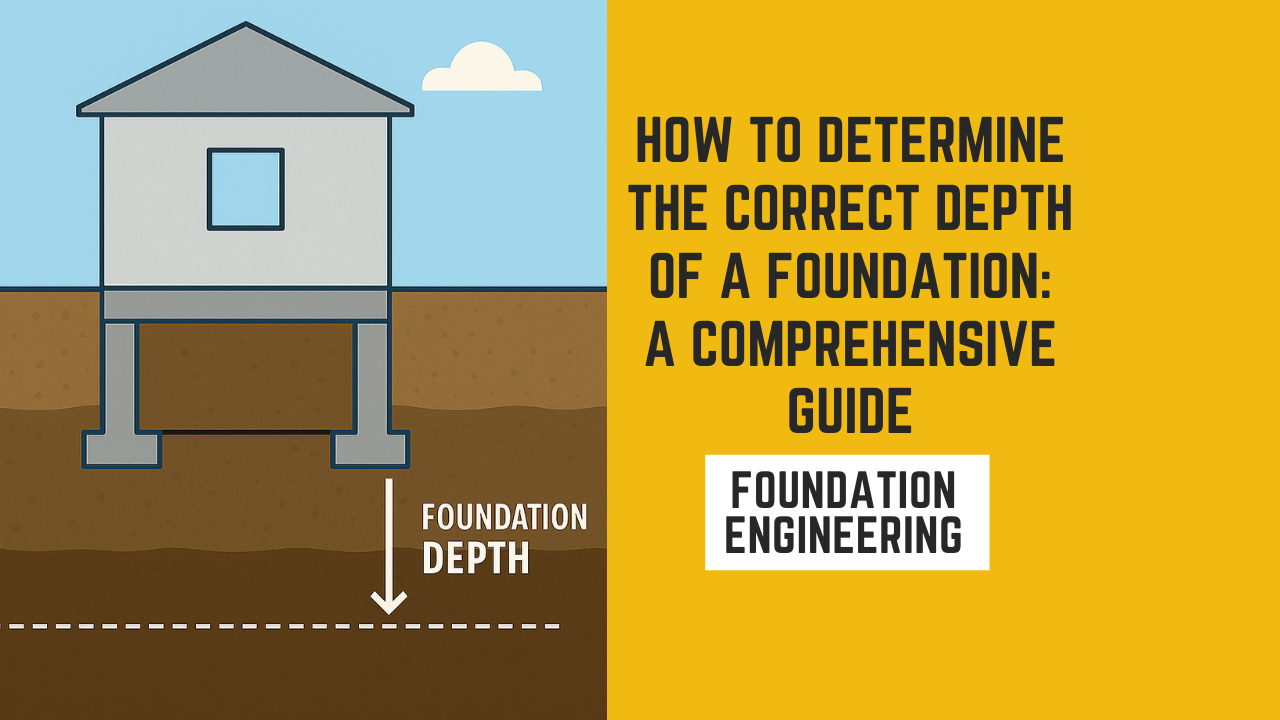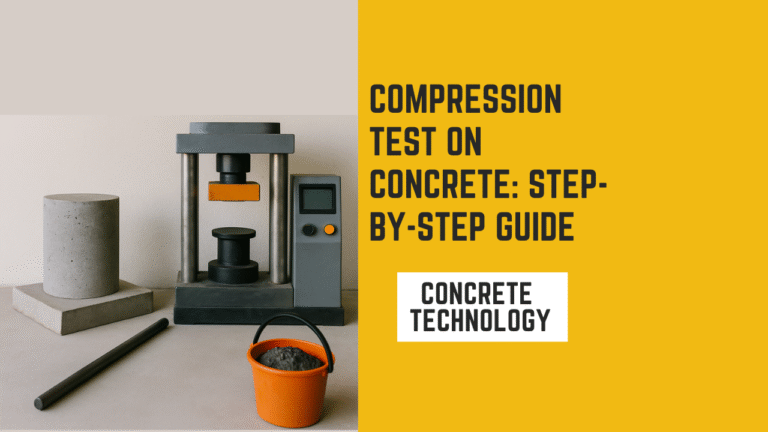How to Determine the Correct Depth of a Foundation: A Comprehensive Guide 2025

Introduction
When it comes to constructing a safe and durable building, one of the most critical steps is establishing a strong foundation. The foundation supports the entire structure and transfers its load safely to the ground. But how do engineers and builders determine the correct depth of a foundation? Choosing the proper foundation depth is essential to avoid structural failures, excessive settlement, and costly repairs in the future.
In this article, we will explore in detail the factors that influence foundation depth, methods to determine it, types of foundations with typical depths, and best practices to ensure a solid and lasting foundation. Whether you are a civil engineering student, contractor, or homeowner interested in construction, this guide will provide valuable insights for your foundation design.
Why Is Determining Foundation Depth Important?
The depth of a foundation directly affects the structural stability, durability, and safety of any construction project. Foundations that are too shallow can cause uneven settling, leading to cracks in walls, floors, and even collapse. Conversely, excessively deep foundations increase construction costs without providing proportional benefits.
Correct foundation depth ensures:
- Load Transfer Efficiency: Properly transfers building loads to a stable soil or rock layer
- Protection Against Soil Movement: Prevents damage from frost heave, soil swelling, or erosion
- Avoidance of Settlement Issues: Minimizes differential settlement that can compromise structural integrity.
- Compliance with Building Codes: Meets legal and safety standards to avoid penalties
Factors Influencing the Correct Foundation Depth
Determining the correct foundation depth is not a one-size-fits-all task. Various factors related to soil, climate, load, and environment must be considered carefully.
1. Soil type and bearing capacity
Soil characteristics play a major role in foundation depth. Different soils have varying abilities to support loads:
Rock or Dense Soil: Strong soils like bedrock or dense gravel have high bearing capacity and may require shallow foundations.
Loose or Soft Soil: Clay, silt, peat, or loose sand have low bearing capacity and might require deeper foundations or special ground improvement techniques.
Testing soil samples in a geotechnical investigation helps determine the bearing capacity and recommended foundation depth.
2. Frost Line (Frost Depth)
In colder climates, the foundation must extend below the frost line to prevent frost heave. Water in soil freezes and expands, pushing the foundation upward, which damages the structure.
The frost line varies by location and climate, typically between 600 mm and 1800 mm (2 to 6 feet) deep in many regions. Foundations must be deeper than this depth in cold areas.
3. Water Table Level
High groundwater levels can reduce soil bearing capacity and cause foundation instability. Foundations must be designed to resist buoyant forces and avoid water infiltration.
If the water table is near the surface, deeper foundations, waterproofing, or drainage systems may be required.
4. Load of the Structure
Heavier buildings demand deeper foundations to distribute weight safely. Multi-story buildings and industrial facilities usually require deep foundations like piles or caissons.
Lighter structures such as residential homes or small commercial buildings can often use shallow foundations.
5. Type of Foundation
Different foundation types have standard depth ranges based on their design and purpose:
Shallow Foundations (Spread Footings, Raft Foundations): Usually 0.5 m to 3 m deep.
Deep Foundations (Piles, Drilled Shafts): Can extend 10 m or more into the ground.
6. Environmental and Site Conditions
Sloping sites, the presence of expansive soils, nearby excavations, or seismic activity influence foundation depth to ensure stability under different forces.
Methods to Determine the Correct Foundation Depth
Engineers use several approaches and investigations to determine foundation depth precisely.
Geotechnical Site Investigation
The most reliable method involves drilling boreholes and collecting soil samples at various depths. Laboratory tests assess
- Soil types and stratification
- Bearing capacity
- Moisture content
- Plasticity and shrink-swell potential
- Groundwater level
The geotechnical report recommends safe foundation depth based on soil behavior.
2. Standard Penetration Test (SPT)
SPT measures soil resistance by driving a split-barrel sampler into the ground and recording blow counts. Higher blow counts indicate denser soils capable of supporting loads near the surface.
3. Plate Load Test
A plate is placed on the soil surface, and a load is applied to measure settlement. This test helps confirm the bearing capacity of shallow soils.
4. Empirical and code-based guidelines
Local building codes and engineering handbooks provide minimum foundation depths for different soil types and climates. These serve as preliminary guides before detailed investigations.
For example,
- Minimum foundation depth for frost protection: typically 900 mm of (3 feet) or as specified by local codes
- Minimum depth for shallow footings: Usually 450 mm to 600 mm below ground surface.
Typical Foundation Depths for Various Foundations
Understanding typical foundation depths helps in estimating project requirements.
| Foundation Type | Typical Depth Range | Common Uses |
| Strip Footing | 0.6 m to 1.5 m | Load-bearing walls in residential homes |
| Spread Footing | 0.5 m to 3 m | Columns and isolated loads |
| Raft (Mat) Foundation | 0.5 m to 3 m | Poor soil conditions, heavy loads |
| Pile Foundations | 10 m to 30 m or more | Weak soil, high-rise buildings |
| Caisson Foundations | 10 m to 30 m or more | Bridges, deep foundations |
Step-by-Step Process to Determine Foundation Depth
Step 1: Conduct Preliminary Site Assessment
- Observe soil type and surface conditions.
- Identify the water table and drainage.
- Check climate and frost line depth.
Step 2: Perform Geotechnical Investigation
- Collect soil samples at different depths.
- Conduct SPT and lab tests to determine bearing capacity.
- Locate the water table and note soil stratification.
Step 3: Calculate Structural Loads
- Estimate total load from building weight, live loads, and environmental forces.
- Decide the foundation type based on loads and soil properties.
Step 4: Apply Building Code Requirements
- Use local codes for minimum foundation depth, frost protection, and other regulations.
- Adjust depth according to soil bearing capacity and structural needs.
Step 5: Finalize Foundation Depth and Design
- Choose a depth that balances safety, cost, and construction feasibility.
- Design the foundation size and reinforcement accordingly.
Best Practices and Tips
- Always rely on professional geotechnical investigations before finalizing foundation depth.
- Consider soil improvement methods (compaction, grouting) if shallow soils are weak.
- Use drainage solutions to lower water table impact on foundations.
- Avoid excavating too shallow to prevent frost heave and settlement.
- For high seismic zones, consult structural engineers for specialized foundation depth and design.
Conclusion
Determining the correct depth of a foundation is a critical engineering decision that ensures the safety, stability, and longevity of any building. It requires thorough understanding of soil conditions, climate factors, structural loads, and adherence to building codes. By conducting detailed geotechnical investigations and following proven design procedures, engineers can specify the appropriate foundation depth that optimizes cost and safety.
Proper foundation depth protects your investment and creates a safe environment for occupants for decades to come.






